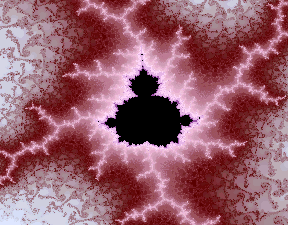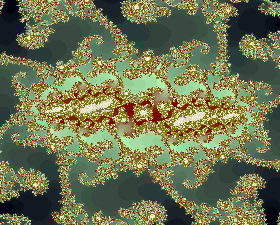| These images come from the Mandelbrot set gallery of Frank Roussel, |
|
http://graffiti.u-bordeaux.fr/MAPBX/roussel/fractals.html. |
| Applets to explore Julia sets and the Mandelbrot set, and other fractal topics,
can be found at Bob Devaney's website |
| Dynamical Systems and Technology
Project |
| We have our own piece of Mandelbrot set software. |
| From a philosophical perspective, the Mandelbrot
set challenges familiar notions of simplicity and complexity: how could such a
simple formula, involving only multiplication and addition, produce a shape of great
organic beauty and infinite subtle variation? |
| Also, deep mathematics underlies the
Mandelbrot set. Despite years of study by brilliant mathematicians (three of whom
won Fields Medals), some natural and simple-to-state questions remain unanswered.
Much of the rebirth of interest in complex dynamics was motivated by efforts to
understand the stunning images of the Mandelbrot set. |
| In addition, as we shall see,
hidden within it are metaphors (and more) for some of the richness of contemporary
literature and music. |
| Finally, some
instances are just plain entertaining, in one way
or another. |





